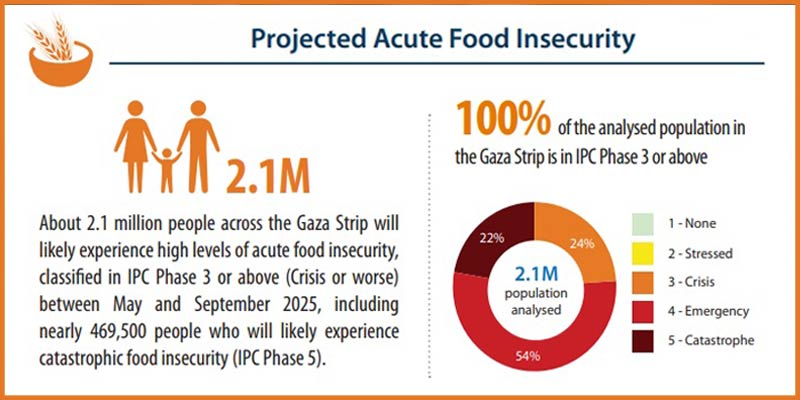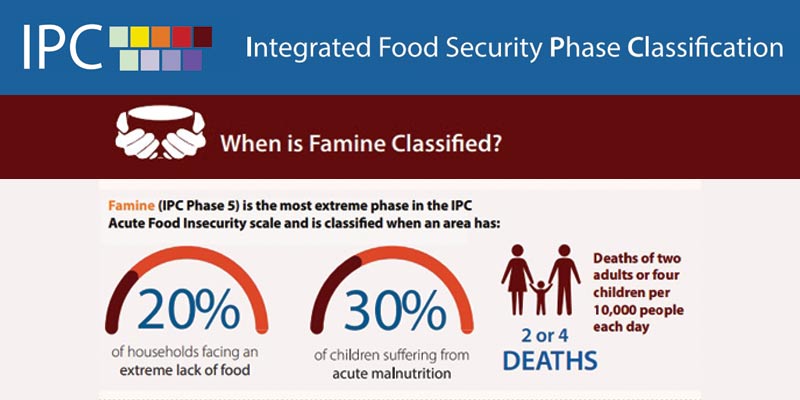- World
- May 13
Risk of famine across all of Gaza, warns IPC
• Populations across the Gaza Strip are at risk of famine as fighting has surged again, border crossings are still closed, and food is dangerously scarce.
• Hunger and malnutrition have intensified sharply since all aid was blocked from entering on March 2, reversing the clear humanitarian gains seen during the ceasefire earlier this year.
• According to the Integrated Food Security Phase Classification (IPC) snapshot released on May 12, as many as 470,000 people in Gaza are facing catastrophic hunger (IPC Phase 5), and the entire population is experiencing acute food insecurity.
• The report also projects an alarming 71,000 children and more than 17,000 mothers will need urgent treatment for acute malnutrition. At the beginning of 2025, agencies estimated 60,000 children would need treatment.
• The IPC snapshot for Gaza projects that renewed military operations, the ongoing complete blockade, and the critical lack of supplies needed for survival could push food insecurity, acute malnutrition and mortality levels past the famine thresholds in the coming months.
• Border crossings into Gaza have been closed for over two months - the longest the population has ever faced – causing food prices in markets to spike to astronomical levels, putting what little food is available out of reach for most families.
• Prices have soared for basics such as a 25 kilogramme sack of wheat flour, which now costs between $235 and $520, representing a 3,000 per cent price spike since February.
Recommended actions:
i) End hostilities: An immediate, unconditional, and sustained ceasefire is critical to reducing the risk of famine and reversing the catastrophic levels of human suffering.
ii) Ensure humanitarian access: Unhindered, safe, stable and sustained humanitarian access must be guaranteed to deliver lifesaving, multi-sectoral assistance and services at scale. This includes food, healthcare, water and sanitation (WASH), essential non-food items, fuel and cooking gas.
iii) Protect aid workers, civilians and civilian infrastructure: Protect civilians and aid workers so they can deliver humanitarian assistance unimpeded. Protect and restore infrastructure critical for survival and for the delivery of humanitarian assistance and services, and regular functioning of food, health, water and sanitation systems.
iv) Food assistance alone will not prevent famine: Provide lifesaving humanitarian assistance through multi-sectoral, integrated interventions, including food, nutrition, health, WASH, and livelihoods assistance.
v) Restore supply chain: Restore at scale commercial supply, essential services, market systems and local production.
Integrated Food Security Phase Classification (IPC)
• The Integrated Food Security Phase Classification (IPC) is an innovative multi-stakeholder initiative to improve analysis and decision-making on food security and nutrition.
• Using the IPC classification and analytical approach, governments, UN agencies, NGOs, and other stakeholders work together to determine the severity and extent of acute and chronic food insecurity and acute malnutrition situations within countries, according to internationally recognised standards.
• The IPC was developed in 2004 by the Food Security and Nutrition Analysis Unit (FSNAU), managed by the Food and Agriculture Organisation of the United Nations (FAO) in Somalia.
• The request for a food security measurement tool was motivated by a growing need for rigorous, evidence-based, consensus-based and actionable food security information to facilitate an effective humanitarian response in the Somali context.
• The IPC became more widely applicable in the following years, as it served as a “common currency” for food security and nutrition analysis.
• Since its inception, the IPC initiative is now described as the ‘global standard’ for classifying acute food insecurity and malnutrition affecting millions globally.
• The IPC has proved to be one of the best practices in the global food security field, and a model of collaboration in over 30 countries in Latin America, Africa and Asia.
IPC Classification System
• The IPC Classification System distinguishes and links Acute Food Insecurity, Chronic Food Insecurity and Acute Malnutrition to support more strategic and better coordinated responses.
• The protocols used by the IPC are harmonised across the three individual scales (IPC Acute Food Insecurity, IPC Chronic Food Insecurity, and IPC Acute Malnutrition).
• This allows for the analysis of linkages between the three conditions and the possibility of detangling acute food insecurity, chronic food insecurity and acute malnutrition, in support of a more strategic response analysis.
IPC classifies the severity of Acute Food Insecurity into five severity phases:
i) None/Minimal - Households are able to meet essential food and non-food needs without engaging in atypical and unsustainable strategies to access food and income.
ii) Stressed - Households have minimally adequate food consumption but are unable to afford some essential non-food expenditures without engaging in stress coping strategies.
iii) Crisis - Households either have food consumption gaps that are reflected by high or above-usual acute malnutrition; or are marginally able to meet minimum food needs but only by depleting essential livelihood assets or through crisis-coping strategies.
iv) Emergency - Households either: have large food consumption gaps that are reflected in very high acute malnutrition and excess mortality; or are able to mitigate large food consumption gaps but only by employing emergency livelihood strategies and asset liquidation.
v) Catastrophe/Famine - Households have an extreme lack of food and/or other basic needs even after full employment of coping strategies. Starvation, death, destitution and extremely critical acute malnutrition levels are evident. For famine classification, the area needs to have extreme critical levels of acute malnutrition and mortality.
IPC Famine classification
• The IPC sets the global standards for famine classification.
• The IPC plays a critical role in identifying famine conditions, and informing the response needed to save millions of lives.
• Famine is the most severe phase of the IPC.
• The IPC defines famine as an extreme deprivation of food. Starvation, death, destitution and extremely critical levels of acute malnutrition are or will likely be evident.
A famine classification (IPC Phase 5) is the highest phase of the IPC Acute Food Insecurity scale, and is attributed when an area has:
a) At least 20 per cent of the population in that particular area are facing extreme levels of hunger.
b) At least 30 per cent of children suffer from acute malnutrition.
c) Two deaths for every 10,000 adults and four deaths per 10,000 children daily due to outright starvation.
• The IPC does not “declare famine” or issue “famine declarations”, but rather facilitates the analysis that allows governments, international/regional organisations and humanitarian agencies to issue more prominent statements or declarations.
Manorama Yearbook app is now available on Google Play Store and iOS App Store


